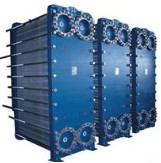

Flow passage design of heat exchanger
Plate heat exchanger plate is widely used in metallurgy, petroleum, chemical, food, pharmaceutical, shipbuilding, textile, paper and other industries, is heating, cooling, heat recovery, fast sterilization and other purposes of the excellent equipment. Plate heat exchanger has become an important equipment for industrial production, waste heat utilization and building comfort. At present, the production of heat exchanger units, heat pump units, refrigeration units, evaporation devices, air cooling equipment and catalytic reforming unit, etc.. In the future, with the continuous development of the economy, there will be more devices.
The heat exchanger is the principle of plate heat exchanger consists of two parts: metal plate: according to the different heat transfer conditions are pressed into different shapes in order to ensure the best effect; rubber gaskets: installation in the gasket groove along the plate surrounding, to form a seal and the media diversion. The metal plate is arranged in a frame with a fixed plate and a movable clamping plate on one side. A sealing gasket is arranged on the plate, the fluid channel is sealed, and the fluid is alternately flow into the respective channels. The number and size of the plate are determined by the flow, physical properties, pressure drop and temperature difference of the fluid. Corrugated plate not only improves the degree of turbulence, and the formation of many supporting points, enough to withstand the pressure difference between the media. A metal plate and a movable plate hanging on the guide rod, and the positioning guide rod, and the rod end is fixed on the support column, because of the excellent performance, space saving, energy saving, easy maintenance and many other advantages, has been highly affirmed the heat exchanger industry.

The use of heat exchanger 1--2 years after the need to conduct the necessary inspection, cleaning, pressure test, etc.. For the problems such as deformation or perforation of the board need to be replaced in time, in the process of heat sink assembly must be strictly in accordance with the flow chart. The flow chart is designed according to the cooling process, the way of the parallel or series plate connected to a common process and double flow (or flow combination) heat exchanger, medium access single flow heat exchanger and outflow pipe is usually fixed plate side of the heat medium and the cold medium respectively in the unilateral arrangement fixing plate of the vertical axis, with a medium at the same time and in the right or left. The heat exchanger channel, lateral heat sink and transverse septum Cuoceng, staggered, horizontal heat exchanger and transverse septum, between the transverse heat exchanging sheet and insulation or insulation block between the inner wall and lateral wall between the spacer and the heat exchanger are formed by the gap, refrigerant flow channel transverse and longitudinal to the flow channel and connected, constitute whole refrigerant flow channel. The heat exchanger channel quality requirements of high temperature and pressure resistance, good heat insulation layer or piece of material; heat insulation requirements of high temperature and pressure resistance and good insulation; bearing shell material with high temperature resistance, high pressure resistance, poor thermal conductivity; thermal insulation material with high temperature resistance, good insulation.







